![]()
![]()
![]()
Use LEFT and RIGHT arrow keys to navigate between flashcards;
Use UP and DOWN arrow keys to flip the card;
H to show hint;
A reads text to speech;
36 Cards in this Set
- Front
- Back
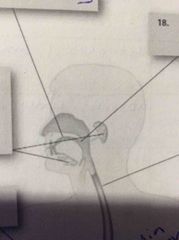
Front (Term) |
Mouth cavity (tongue) Pharynx Salivary glands (dissolves food) Oesophagus |
|
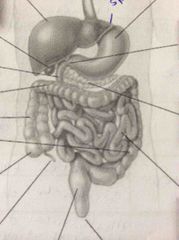
Front (Term) |
Pancreas (produces pancreatic juice containing enzymes) has pancreatic duct Illeum (last part) Jujenum (2nd part) Duodenum (1st part of small intestine) Ascending colon Transcending colon Descending colon Caecum (start of large intestines) Gall bladder (stores + produces bile) has bile duct Liver (produces bile that emulsified liquids) Appendix Rectum (final part of large intestines) Anus (open surrounded by anal sphincter) Stomach (mechanical digestion by churning action and chemical digestion by pepsin) Cardiac sphincter Pyloric sphincter |
|
|
Define Digestion |
Process of the mechanical and chemical breakdown of larger food molecules into small molecules (nutrients) that can be absorbed into the blood and cell. Chemical - chemically broken down via enzymes into nutrients |
|
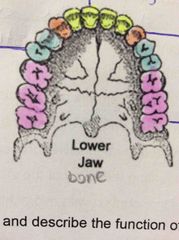
Front (Term) |
Incisor - cutting & biting Canines - tearing & gripping Premolars & molars - crushing, chewing & grinding |
|
|
Digestion in mouth |
Chemical - enzyme pepsin (salivary amylase, mucus, digestive enzymes) secreted by salivary glands (breaks down carbs) Mechanical - chewing food by teeth |
|
|
How food goes down the oesophagus |
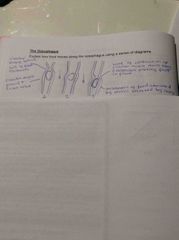
Back (Definition) |
|
|
digestion in stomach (mechanical) |
Stomach is hollow muscular organ located in middle of abdomen Mechanical - waves of muscular contraction that moves along stomach wall Gastric juice + food -> thick soup (Chyme) Oblique, circular, longitudinal muscles allow stomach to contract in variety of ways Pyloric sphincter regulates flow of material from stomach to duodenum (2-8 hrs) |
|
|
Microvilli |
Tiny microscopic projections covering cells covering outside villi |
|
|
Structure of villi |
Lymph capillary (lacteal) surrounded by network of blood capillary 1mm long covered by single layer of cells Continual movement of villi by muscular movements of intestinal wall |
|
|
Absorption in blood capillary (Villi) Where it go? |
Amino acids Glucose Minerals Water soluble vitamins Water Goes to liver via hepatic portal |
|
|
Absorption in lacteal (lymph) |
Fatty acids Glycerol Fat soluble vitamins |
|
|
Absorption in large intestines And whats left? |
Water Minerals & Water soluble vitamins ————————— Fibre Bile Ruben (red) Bile Verden (green) |
|
|
Stages of digestive process |
Ingestion Digestion Absorption Egestion |
|
|
Major food groups |
Carbs Protein Fats Vitamins Minerals Fibre/roughage Water |
|
|
Carbs |
Carbs -> Maltose -> glucose (Mouth) salivary amylase + starch -> maltose (Stomach) no digestive carb enzymes (Duodenum) pancreatic amylase + starch -> maltose (Ileum) moltase + maltose -> glucose |
|
|
Protein |
Protein -> Peptides -> amino acids (Mouth) no digestive protein enzymes (Stomach) pepsin + protein -> peptides (Duodenum) trypsin + proteins -> peptides (Ileum) Erepsin + peptides -> amino acids |
|
|
Small intestines (mechanical) |
6m long Duodenum where final breakdown of carbs proteins lipids Wave of contraction (peristalsis- longitudinal & segmentation- circular) of muscles churns food. Bile salt - emulsification large fat globules to small fat globules (increase surface area which lipase enzymes can act on) |
|
|
Villi diagram |
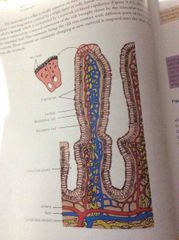
Back (Definition) |
|
|
Small intestines (chemical) Pancreatic juice contains: |
Pancreatic amylase, which breaks down starch into disaccharides Pancreatic protease, breaks down proteins and polypeptides into peptides Pancreatic lipases breaks down fat into fatty acid and glycerol Ribonuclease & deoxyribonuclease digests RNA & DNA |
|
|
Small intestines (chemical) Intestinal juice contains: |
Amylase breaks down disaccharides into simple sugar Peptides breaks down peptides into amino acids Lipases breaks lipids into fatty acids and glycerol |
|
|
Alimentary canal |
Continuous tube from mouth to anus Mouth -> pharynx -> oesophagus -> cardiac sphincter -> stomach |
|
|
6 basic activities of digestive system |
Ingestion mechanical digestion Chemical digestion Movement of food Absorption Elimination of waste |
|
|
Alimentary canal |
Continuous tube from mouth to anus Mouth -> pharynx -> oesophagus -> stomach -> small intestines -> large intestines |
|
|
Large intestines |
18-24 hrs Water, vitamins, minerals is absorbed Bacteria breakdown remaining organic compounds Faeces (contains water, undigested food materials, bacteria, bile pigments, remains of cells) is formed & stored |
|
|
Villus |
Mucosa (inner lining) has small finger like projections |
|
|
Mucosa |
Small intestine inner lining that has folds that extend into interior |
|
|
Fats |
(Mouth) no digestive fat enzymes (Stomach) no digestive fat enzymes (Duodenum) pancreatic lipase+ fats -> fatty acids + glycerol (Ileum) pancreatic lipsase + fats -> fatty acids + glycerol |
|
|
Elimination & excretion |
Excretion is removal of metabolic waste (produced by chemical activity) Bile pigment & faeces is not metabolic waste hence referred to elimination Defaecation is elimination of solid waste from rectum |
|
|
Diet affect absorption Large meal? High protein/ fat? Alcohol/ caffeine? |
Stretched & distended stomach, materials pushed in small intestines faster Slow movement Stimulate (increase) movement |
|
|
Constipation |
Movement of large intestines slower Water absorbed, faeces drier & harder Defaecation harder & painful Lack of fibre, exercise or sad |
|
|
Diarrhoea |
Frequent defaecation of water faeces Irritation, more peristalsis, move faster, less absorption of water bacteria infection or food poisoning |
|
|
Why eat fibre? |
Food derived from plants Lower cholesterol levels, decreased risk of heart diseases & cancer, beneficial effects on blood glucose levels Fat on intestine trapped by soluble fibre prevent absorption Fruits, veggies, oat bran, barley, soy products |
|
|
Bowel cancer |
Uncontrolled growth of cells in wall of small intestines Diet, high alcohol, smoking, lack of fibre, red processed meat, overweight, no exercise |
|
|
Coeliac disease |
Can’t tolerate with protein called gluten (wheat rye barley) Immune system damage or destroy villi in small intestine if consumed Nutrients can’t be absorbed & person be malnourished |
|
|
why villus suited for absorption |
network of blood capillary lymph capillary continual movement of villi content always changing |
|
|
Teeths |
Canines - biting cutting Incisors - tearing Premolar & molar - grinding chewing crushing |

